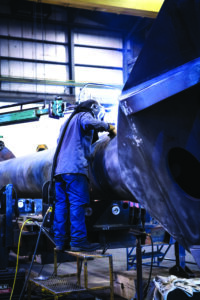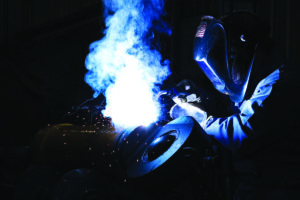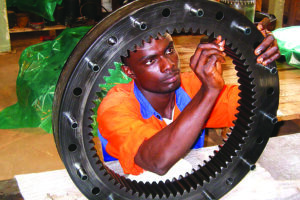
Rebuilds by L&H often perform better than new. For example, the 7495 Dipper Handle Rebuild Program uses proprietary processes and designs that give the component more consistent mechanical properties. (Photo: L&H)
Miners maximize the life and performance of their equipment and can save money by opting for rebuilds
By Jesse Morton, Technical Writer
With staffing and parts shortages persisting, business is solid for suppliers offering rebuilds and related services and solutions. Forward-thinking suppliers have added facilities, equipment and personnel to handle the demand. They serve miners short on maintenance personnel, low on parts inventory, and located far from urban centers. And, they say, they do it relatively quickly, keeping downtime to a minimum. The listed benefits are many. Foremost is empowering the miner with more control and more options.
Reducing Reliance on External Sources
L&H Industrial reported a sharp uptick in business as the supplier helps customers address challenges posed by ongoing industry-wide supply chain disruptions and staffing shortages. “Currently, we are experiencing strong activity from clients worldwide due to our ability to complete all aspects of component rebuilds in-house,” said Jamie Meinen, product line manager, L&H.
“We are seeing increased demand for components that are either dependent on long lead time castings and forgings or those that require heavy fabrication, such as large structural shovel and dragline components,” Meinen said. “This is due to the extended well-above-normal lead times for newly fabricated components throughout the mining sector.”
Many OEMs struggle to meet deadlines now due to staffing and parts shortages, which prompt customers to consider alternatives, like rebuilds. “By leveraging the residual value of existing assets, we can help our customers serve as their own suppliers, reducing reliance on external sources and minimizing supply chain disruptions,” he said.
“One example of this is our ability to salvage hoist bull gear and pinions for rope shovels through precision re-profiling using our Höfler Rapid 6000 gear grinder in Tempe, Arizona,” Meinen said. “These components can be refurbished to exceed AGMA Class 12 standards for precision and quality, allowing our customers to extend the life of their equipment and avoid costly replacements.”
The company works closely with customers for a seamless rebuild process. “This includes providing engineering expertise and technical support to ensure that all work is done to the highest standards,” Meinen said. “Our turnkey solutions are designed to help customers who are short on staff or otherwise are limited in terms of technical expertise and labor.”
The general rebuild process starts with collaborating on an initial scope of work. After that the work is booked, the components are cleaned, and a final scope of work and price is proposed. The project is then managed with full transparency.
“We believe it’s crucial to manage and report schedules to our customers and keep them up-to-date on the progress and quality assurance of their projects,” Meinen said. “Therefore, we work with them to develop a reporting and update cadence that suits their needs,” he said. “This may involve formal Gantt charts, progress reports, or live walk-throughs using video conferencing technologies.”
Each rebuild is different, but commonalities include welding, followed by machining, and a final inspection.
“The typical repair process involves removing damaged or unsalvageable material, pre-machining surfaces before weld build-up to ensure good weld fusion, welding repair, post-weld inspection, post-heat treatment, stress relieving, and post-heat treat NDT inspection,” he said. “After the weld repair is completed, the component is transitioned to the appropriate machining center, where it is set up and prepared for machining.
The machinists work closely with the quality team. The final inspection assesses each component and completes the documentation. “Our inspectors use both fixed-arm and laser tracking precision measuring devices to achieve the most accurate measurements, producing clear and precise final inspection reports,” Meinen said. “If the piece is part of a larger assembly, such as a transmission, the components are fully assembled and tested on our test bench before packaging for shipment.”
Savings versus purchasing new can be substantial. “We consider 60% of the cost of a new component to be an average that can be achieved through a remanufactured component,” he said.
Cylinder rebuilds reduce the cost of a traditional rebuild by up to 40% and shorten the overall lead time by up to one month using the supplier’s Advanced Sealing Designs, he said. “This is achieved while maintaining the same or better life expectancy for the component.”
Rebuilds are at “OEM specifications and we are often able to implement design enhancements that result in a component that can be considered better than new,” Meinen said. “Additionally, the quality of our services coupled with innovative design improvements allows us to offer service warranties that meet or exceed OEM offerings for new components.”
The topmost benefit may be improved productivity. The rebuild often is now customized to the specific application and operation. “This can result in increased efficiency and reduced downtime,” Meinen said.
“Additionally, L&H’s remanufacturing services can restore worn or damaged components to like-new condition, providing a cost-effective alternative to purchasing new components,” he said. “This not only saves money, but it can also extend the lifespan of equipment, reducing the need for frequent replacements.”
The company offers a range of field services, including equipment installation and maintenance, which can help a customer maximize uptime. “Finally, L&H’s design and technical support services can help customers improve their own maintenance and repair processes, enabling them to operate more efficiently and effectively,” Meinen said. “Overall, L&H Industrial’s comprehensive suite of services and expertise can help customers improve their productivity and profitability.”

For a repair by L&H, the weld process consists of removing any damage, pre-machining, welding, a post-weld inspection, post-heat treatment, stress relieving, and post-heat treat NDT inspection. L&H now uses Hyperfill welding, Cleveland Lincoln Electric’s high-deposition welding system. (Photo: L&H)
An example of one such service is the 7495 Dipper Handle Rebuild Program. The program is critical because typically the dipper is misused. “Due to this, certain areas of the structure have been prone to failure,” Meinen said. “Previously, these failures were repaired by conducting crack repair using the existing material, which often yielded results that were far inferior to the original weld, resulting in the handles being scrapped after just a few rebuilds in many operations.”
L&H seized the opportunity to improve the rebuild process. “We incorporated a forged transition in place of the large structural transition casting used in the original design to marry the tube with the yoke end of the handle,” he said. “The forged transition provides better and more consistent mechanical properties than the original cast option.”
L&H also developed a proprietary welding process for the joint that “offers unmatched weld quality in the critical joint,” Meinen said. “To ensure the quality of the joint, we invested in an encoded phased array UT system, which provides an accurate and repeatable inspection of the joint,” he said. “The end-user can use this inspection as a baseline to track the units once they are returned to operation.”
L&H solutions and offerings are available to any mine, regardless of location. “We have a dedicated team focused on international logistics and shipping, which enables us to navigate the challenges that come with collecting and returning goods for repair from even the most remote locations,” Meinen said. “In addition, our worldwide network of sales and support personnel and partners means that we are well-equipped to provide the necessary support and resources to adopt a reman or rebuild service for any mining operation, no matter how far away it may be.”
Separately, L&H Industrial announced it now uses Hyperfill welding, Cleveland Lincoln Electric’s high-deposition welding system. “Hyperfill welding significantly increases our weld deposition rates while maintaining the high-quality welds our customers expect,” Meinen said. “This allows us to perform welding operations more efficiently on many of our structural rebuilding projects.”
The supplier also announced adding equipment, to include a vertical turning lathe, to the Tempe, Arizona, facility. That “will increase our capacity for large-dia. and heavier structures and improve our throughput for components that we regularly manufacture and remanufacture,” he said. “This will provide a 300% increase in machining efficiency for completing a shovel swing rack.”
L&H is adding offerings, to include in-situ and in-shop repair and upgrade services for crushers. The company is expanding offerings to support the processing side of operations, Meinen said. “We are excited to continue providing innovative solutions to our customers’ rebuild needs.”

To service short-staffed miners, Flanders has six North American Regional Service Centers, seven International Regional Service Centers, and strategically sited field service and engineering teams. (Photo: Flanders)
Ensuring Better Performance, Reliability
Flanders reported increased demand for motor rebuilds is being driven by industry-wide staffing and parts shortages. Currently, the supplier offers repairs, rebuilds and upgrades to a vast range of electric motors.
Specifically, the rebuild procedures “all follow the same ISO9001 process, whether it is a 500 hp or a 15,000 hp,” said Mike Casson, director, business development, mining and mills. That process starts with an initial inspection, disassembly, pre-testing, cleaning and drying, then more comprehensive testing.
“From this testing, a repair work-scope is developed to bring the unit back to new specifications along with a RCFA when applicable,” he said. “Depending on the specific motor, often we will also offer specific component upgrades to ensure better performance or reliability.”
After that, the documentation is completed, a deadline set, and the repairs and upgrades are completed. “Final steps are test running with appropriate vibration, thermal, and electrical checks, then final paint and preparation for shipping,” Casson said.
Currently, Flanders is seeing elevated demand for motor upgrades that can help deliver higher performance from production equipment. “In many cases, we can upgrade a motor to deliver increased torque or higher speeds,” he said. “This requires a holistic look at the entire system to ensure the motor operates within the mechanical limits of the machine, but can often result in significant increases in production for the end user.”
Upgraded motors are usually coupled with Flanders Freedom control systems, which help deliver production increases.
Higher productivity is one of four primary benefits offered. “Flanders goal as a company can be simplified by four words: Safety, quality, reliability, and productivity,” Casson said. “Safely increasing productivity and reducing downtime results in a lower cost per ton, which is really the goal in all mining applications.”
Another benefit offered is cost savings over buying new. “The percentage costs of repair versus replace will vary depending on AC versus DC, motor size, and application,” he said.
“Often, however, even a repair cost that is a large percentage of replacement cost remains the best option,” Casson said. “While most factory-built motors are well designed, some have inherent flaws in the design or the OEM materials used that can make a Flanders repaired or upgraded motor significantly ‘better than new.’”
To help customers minimize downtime when having a motor worked on, Flanders maintains a “comprehensive stock of exchange spares,” he said. “When a customer does not have a spare or perhaps loses two units back to back, we can often provide a Flanders-owned spare so the machine can get back in production quicker, rather than waiting on a ‘rush’ repair turnaround.”
For customers that may be short-staffed, the company offers a wide range of services, from troubleshooting to turnkey maintenance programs.
Flanders’ field service team is managed as a whole rather than as individual groups. “That way we can pull people or teams together from a variety of regions to provide service nearly anywhere,” he said. “Likewise, with our exchange spare program, we can often send a spare unit immediately.”
Separately, Flanders and Hofmann Engineering signed a memorandum of understanding to strategically align the companies’ electrical and mechanical engineering expertise, capabilities, and production facilities. The development should provide customers with turnkey, world-class aftermarket electro-mechanical wheel motor solutions for trucks, Flanders said.
“We have recently formed an agreement with Hofmann Engineering to provide the gearing and some other mechanical components for wheel motor planetaries, which greatly enhances our turnaround time with improved component availability,” Casson said.
The MOU also lays the groundwork for future expansion into supplying repairs, rebuilds, and upgrades to other mobile mining equipment models or components, said Erich Hofmann, managing director, Hofmann Engineering. “We see ourselves as the supplier of choice for aftermarket mechanical and electrical solutions to the mining equipment market.”

Each Liebherr Mining Reman component is inspected, repaired and tested using comprehensive OEM guidelines and specialized tooling in Liebherr certified facilities. (Photo: Liebherr)
Increasing Availability, Productivity
Liebherr reported that roughly half of the major components it supplies are remanufactured. The high demand for remanufactured components is due to the comparatively high availability and rapid order completion, said Jeffrey Rounds, head of Liebherr Mining Reman division.
“Customers can expect their equipment to be up and running after only minimal downtime,” he said. “This increases the availability and productivity of the machine.”
When a component at the end of its lifecycle is returned with no major damage, the customer can receive a credit from the OEM. After that, the initial steps include disassembly, inspection, testing and cleaning.
Next, the parts that can be reused are “remanufactured to as-new quality using traditional machining, additive manufacturing, and specialized surface coatings,” Liebherr said. The component is then “assembled to the latest factory specifications” and supplied to the customer or distributor.
Typically, “Reman components cost up to 60% less than new components,” Rounds said.
Some of those savings result from lower material costs. “High-quality remanufactured parts are a considerably more cost-effective choice than purchasing brand-new components,” he said. “The amount of raw materials, energy and resources needed to produce a remanufactured component is significantly lower than when building a component from scratch, thus reducing the cost of production.” That ultimately translates into cost savings for customers.
Customers that partner with the OEM on a remanufacturing program can initially lock in prices and agree to favorable exchange plans and terms. This can lead to additional savings down the road because it means the OEM becomes more of a stakeholder in the health and lifecycle of the machines and components.
“No one knows Liebherr machines, as well as Liebherr, does, and so it is the same case with Reman parts and components,” Rounds said. “This means that customers can expect their machines to continue operating smoothly and efficiently for extended periods of time, without the need for costly replacements due to a lack of quality components.”
Liebherr Mining Reman components come with “the same as-new warranty and performance, guaranteed,” he said. “Overall, Liebherr Mining Reman offers the most economical solution for customers’ needs, reducing the total cost of ownership and increasing the lifespan of their machines.”
The service program also helps the supplier and customer cut waste. “Within Liebherr Mining, the Reman program is used to reuse energy intensive materials from the core and reintroduce them to the supply chain as refurbished, top-quality Liebherr Reman products,” Rounds said. “By adopting this approach, Liebherr Mining seeks to minimize waste by reusing as much material as possible from each core.”
Worldwide the OEM has 13 remanufacturing facilities and 22 sales and service companies with parts warehouses. Most recently, the OEM added reman capabilities to the new Panama facility “to support the customers in South America,” Rounds said. “We have ongoing expansion projects at existing Remanufacturing hubs for Indonesia and Australia.”






